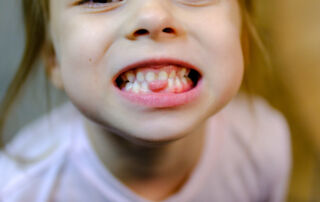Friendly Orthodontics Tips and Guidance
First Things First: Orthodontics Care
While we continuously focus on the latest updates in orthodontics care, how we’re improving, and how you can have the smile you want without all the pain that is generally associated with orthodontics, we also have tips for at home dental and orthodontic care you might have missed. Here’s some key points not to miss!
Latest Articles from Ahava Orthodontics
How Thumb Sucking Impacts Teeth Alignment (and How to Fix It)
We help families in Fort Worth address one of the most common childhood habits that can lead to serious dental issues: thumb sucking. At Ahava Orthodontics, Drs. Andy and Shawne Barron work with parents to understand how this habit affects teeth alignment and provide gentle, effective solutions to fix it before long-term damage occurs. Thumb sucking is a natural reflex for infants and toddlers. It provides comfort, helps with self-soothing, and is generally harmless in the early years. However, if the habit continues past age 4 or when permanent teeth begin to emerge, it can interfere with the natural growth and positioning of the teeth and jaw. How Thumb Sucking Affects Developing Teeth The biggest concern with [...]
What Causes Misaligned Teeth in Children and How to Treat It Early
We provide early orthodontic care in Fort Worth at Ahava Orthodontics to help families prevent and treat misaligned teeth in children before problems become more complex. Drs. Andy and Shawne Barron are passionate about identifying the true causes of crooked teeth, allowing for timely, gentle treatment that sets the stage for a healthy, confident smile. Misaligned teeth are not just a cosmetic issue—they can impact chewing, speech, and oral hygiene. Parents often wonder why their child’s teeth are growing in unevenly or why their bite doesn’t look quite right. The truth is, a variety of factors can contribute to early orthodontic issues, and many are preventable or manageable with early care. Common Causes of Misaligned Teeth in Children To [...]
How Mouth Breathing Affects Jaw Development and Teeth Alignment
We help families in Fort Worth protect their children’s health and smiles at Ahava Orthodontics by addressing a silent issue many overlook—mouth breathing. While it may seem harmless, chronic mouth breathing can dramatically influence jaw development and teeth alignment, especially during key growth years. Mouth breathing often begins subtly, perhaps due to allergies, enlarged tonsils, or chronic nasal congestion. But over time, the way a child breathes can change the shape of their face, interfere with normal bite development, and even lead to long-term oral health challenges. Understanding how breathing habits affect dental structure is the first step in addressing the root cause and protecting your child’s future smile. How Mouth Breathing Impacts Facial and Jaw Development [...]
The Real Reasons Your Child Might Need Braces (It’s Not Just Crooked Teeth)
We offer expert orthodontic care in Fort Worth at Ahava Orthodontics, where Drs. Andy and Shawne Barron help parents understand the full spectrum of reasons children may need braces—not just for crooked teeth, but for lasting oral health and confidence. When most parents think of braces, they picture a solution for misaligned teeth. While that’s a big part of the story, there’s much more to it. Braces can address a wide range of dental and facial issues that, if left untreated, may cause discomfort, speech difficulties, or even long-term health problems. Understanding the real reasons behind orthodontic treatment can help you make better decisions for your child’s well-being. Early Orthodontic Issues Can Impact Jaw Growth and Development [...]
How Early Orthodontic Evaluations Can Prevent Costly Treatment Later
When most people think of orthodontics, they imagine teenagers with metal braces, awkward smiles, and the anticipation of straighter teeth in the future. But what many parents don’t realize is that orthodontic care can—and should—start much earlier. In fact, scheduling an orthodontic evaluation by the time your child turns seven can make a significant difference in their dental development and potentially save you thousands of dollars in future treatment costs. At Ahava Orthodontics in Fort Worth, Drs. Andy and Shawne Barron specialize in early orthodontic intervention designed to guide growth, prevent complex issues, and reduce the need for invasive treatments down the road. Here’s why early evaluations matter and what they can do for your child’s future smile and [...]
Myobrace vs. Braces: Which Orthodontic Treatment Is Right for Your Child?
Choosing the right orthodontic treatment for your child can feel overwhelming, especially when there are so many options available. Among the most discussed treatments today are traditional braces and the increasingly popular Myobrace system. While both work to align teeth and improve oral health, they do so in very different ways. Understanding these differences can help you decide which path is right for your child’s needs, development, and lifestyle. The Purpose of Each Treatment Traditional braces are a well-known and time-tested solution for correcting misaligned teeth, bite issues, and jaw problems. Metal or ceramic brackets are bonded to each tooth and connected with wires that are adjusted periodically to guide teeth into better alignment. The Myobrace system, [...]
My Child’s Teeth Are Crowding—What Should I Do Next?
Noticing that your child’s teeth are coming in crowded can be concerning, but the good news is that early action can make a big difference. Dental crowding in children is more than just a cosmetic issue—it can lead to long-term oral health problems if left untreated. If you’re seeing overlapping teeth, twisted teeth, or not enough space for new teeth to erupt, here’s what you should know and what steps to take next. Why Teeth Crowding Happens Crowding occurs when there isn’t enough room in the jaw for all of the teeth to erupt into their correct positions. This lack of space causes teeth to shift, overlap, or rotate, and can prevent permanent teeth from coming in [...]
When Is the Best Age for Kids to Get Braces?
Early orthodontic evaluations can help identify and address potential issues before they become more severe, potentially reducing the need for extensive treatment later on. Determining the optimal time for a child to receive braces is a common concern among parents. While each child's dental development is unique, there are general guidelines that can help in making this decision. The Ideal Age for Braces Most orthodontists recommend that children have their first evaluation around age 7. At this age, a child typically has a mix of baby teeth and permanent teeth. This early visit doesn’t mean braces are needed right away—but it gives the orthodontist an opportunity to assess how the teeth and jaws are developing and determine if early [...]
Top-Rated Fort Worth Orthodontist
In the heart of Fort Worth, nestled amidst our vibrant city with more than a century of history, is a place where smiles are not just fixed, but supported to their fullest extent so that they have all of the function and capabilities that they were meant to have. Ahava Orthodontics, a top-rated Fort Worth orthodontist practice, is home to both Dr. Andy Barron, D.D.S. and his wife Dr. Shawne Barron, D.D.S., M.S. who have made it their lifes work to help children have healthy happy smiles that builds their confidence. We combine the latest technology with personalized care to deliver exceptional orthodontic treatment to patients of all ages, usually starting as young as 7 years old. As the [...]
Schedule Your Child’s First Orthodontist Visit
Taking your child to their first orthodontic visit is a milestone in their journey towards optimal oral health. This visit is a proactive step that lays the foundation for a lifetime of healthy smiles. Not only does it provide a chance for early detection and treatment of any potential issues, but it also acquaints your child with dental healthcare in a positive, friendly environment. Starting orthodontic visits early is a recommendation backed by various dental associations globally. But when exactly should this visit occur, and what should you expect? Let's explore these questions further. When to Schedule the First Visit The American Association of Orthodontists recommends scheduling your child's first orthodontic visit around the age of seven. [...]










